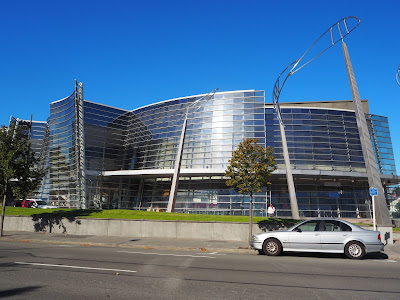Ever since the devastating earthquake that struck Ranau on 5 June 2015 (Read here), people who are directly associated with the design and construction of building structures in Sabah were suddenly made aware that seismic consideration in building design is no longer an option but is mandatory. This requirement has forced all professionals in the engineering consultancy industry to begin a new learning process all over again.
My tour to NZ has added meaning as I also wanted to see first hand the impact of the 22 February 2011 earthquake on Auckland.
To add excitement to our tour to NZ, news of a 5.9 magnitude earthquake (Read here) struck Auckland on 14 February 2016, the very day we flew from KK to Auckland. The news did cause some apprehension and concern to family members and closed friends. Earthquake or no earthquake, we were on our way and any change of plan did not cross our mind.
In Christchurch, we visited the "185 Empty White Chairs" at Cashel Street in Christchurch Central to remember the 185 people killed in Christchurch in the 22 February 2011 earthquake.
In Christchurch, we visited the "185 Empty White Chairs" at Cashel Street in Christchurch Central to remember the 185 people killed in Christchurch in the 22 February 2011 earthquake.
It was reported that the shaking of the February 2011 earthquake of 6.3 magnitude was particularly destructive compared to an earlier one in September 2010. The 2011 earthquake brought down many buildings that had been damaged in September 2010, especially older brick and mortar buildings. Many heritage buildings were badly damaged, including the Anglican Christ Church Cathedral and the Catholic Cathedral of the Blessed Sacrament.
 |
| 185 Empty Chairs |
*************************************************
The partially collapsed Anglican Christ Church Cathedral is now a tourist attraction and a reminder of the unpredictable destructive forces of nature.
According to my ex-university mate who has migrated to Christchurch and now works in the City Council, almost 80% of the buildings in Christchurch Central have been knocked down either because of partial collapse of were deemed unsafe for occupation. Some have been rebuilt while many are still pending re-construction.
 |
| Anglican Christ Church Cathedral. |
 |
| This collapsed building that was knocked down has yet to be rebuilt. |
 |
| Extensive re-construction is going on in Christchurch. |
I was told that bickering and uncertainty have stalled some of the rebuilding efforts. A few are still stuck in insurance claims.
Bickering or otherwise, residents in Christchurch have learned to live with earthquakes. Since the 2011 earthquake, the risk of building collapse is probably very much reduced because most old buildings and structurally unsound buildings have all been torn down. All new buildings are built with improved design which takes account of seismic forces and better materials. New buildings are now so much stronger to withstand seismic forces. In fact there was no report of major damage to building structures and fatality in the recent February 2016 earthquake.
Tourists are not deterred by earthquakes and still flock to Christchurch to enjoy what it offers.
 |
| Punting in Avon River. |
 |
| City Tram. |
 |
| Small Park in Christchurch Central. |
 |
| Christchurch Botanic Gardens. |
*************************************************
I was particularly impressed by the generosity of Christchurch that the Arts Gallery is opened to all visitors free of charge. The building suffered significant damage after the February 2011 earthquake and then underwent extensive refurbishment. This was only reopened on 19 December 2015. It looked brand new when we visited it on 4 March 2016.
 |
| Christchurch Arts Gallery. |


No comments:
Post a Comment